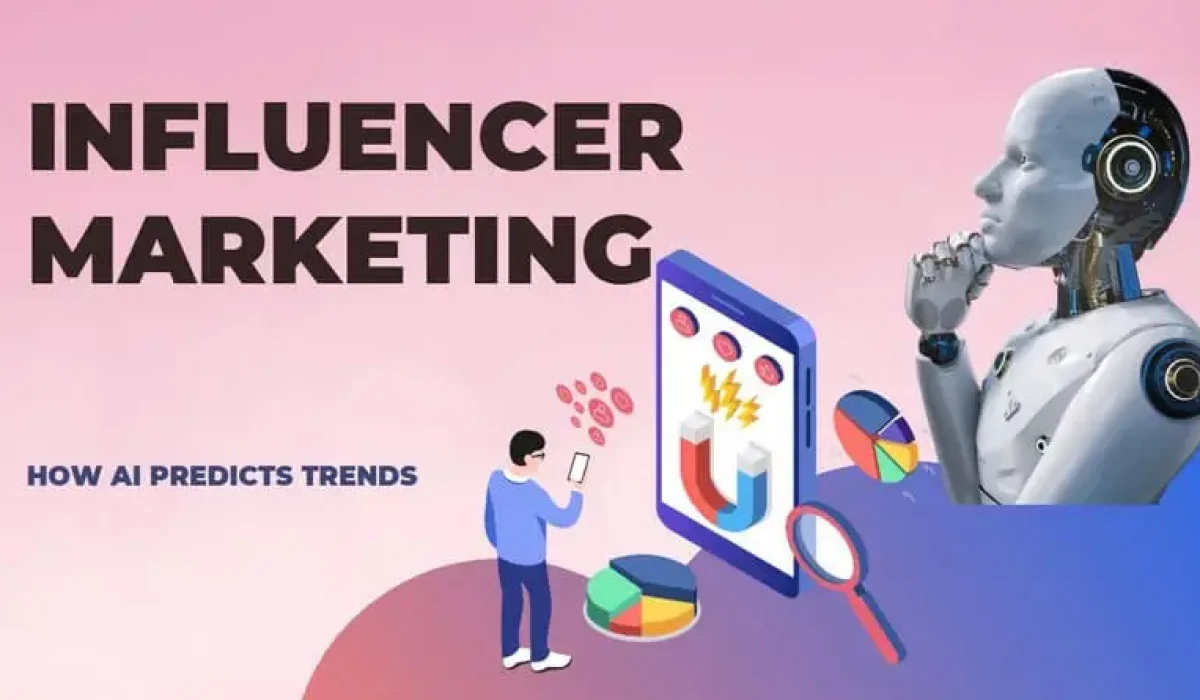Influencer marketing has become a major strength in the advertising industry, which cost $ 16.4 billion in 2022. As this domain develops rapidly, the integration of artificial intelligence (AI) into marketing strategies increases quickly. This document explores how AI technologies empower marketers to predict emerging trends with precision and agility. We will dive into four effective AI-driven methods that revolutionize trend prediction, explore real-world case studies, and provide practical steps for successful AI adoption in influencer marketing. Understanding these approaches equips marketers to stay ahead in a competitive landscape by optimizing campaigns based on data-driven insights.
Table of Contents
An Overview of AI-Powered Trend Prediction
Detecting Emerging Trends in Influencer Marketing
Artificial intelligence utilizes advanced algorithms to evaluate large data sets, giving it the ability to identify trends that human analysts might overlook. In influencer marketing, AI accesses massive amounts of data from social media, blogs, and other digital channels to identify emerging trends faster than anyone else. Natural Language Processing (NLP) drives this process by analyzing language in real time to discover emerging trends.
Predictive Modeling: Shaping Future-Focused Marketing Strategies
Machine learning models are then trained to predict how these trends will change over time, giving marketers a predictive insight into consumer interests. Forecasts enable brands to customize content strategies that are based on anticipated demand, not just prior behaviors. And by bringing together NLP and predictive modeling, you will also build a powerful toolkit — one that informs proactive marketing decision-making based on real-world signals.
Advancing AI Accuracy and Its Strategic Impact on Influencer Marketing
As AI evolves, it refines the accuracy of trend prediction, allowing marketers to better optimise their resources and maximise the impact of the campaign. This high-level overview sets the stage for a granular exploration of four specific AI applications that propel influencer marketing success, and the detailed trend prediction methods behind each.
4 Key Ways AI Predicts Trends
AI harnesses multiple analytical approaches to detect and forecast trends within influencer marketing. Four prominent methods stand out for their efficacy and actionable outputs:
- Social Listening: Utilizing AI to perform real-time sentiment analysis by monitoring social media mentions, hashtags, and conversations to capture evolving interests and moods.
- Predictive Analytics: Applying statistical and machine learning techniques on historical marketing data to anticipate content performance and trend trajectories.
- Image Recognition: Employing computer vision AI to identify emerging visual themes, product aesthetics, and fashion shifts through analysis of images and videos shared online.
- Network Analysis: Mapping influencer relationships and their social graphs to uncover key nodes and collaboration opportunities that drive trend propagation.
Each of these AI methods provides a unique facet to the comprehensive understanding of market and cultural shifts, empowering marketers’ insights far beyond intuition or manual observation.
1. Social Listening: Real-time Sentiment Analysis
Early Trend Detection and Sentiment Analysis with AI Social Listening
Social hearing uses AI algorithms to scan social media platforms for mentions of brands, products, and relevant keywords, tracking how the audience responds. This involves sentiment scoring, where mentions are classified as positive, negative, or neutral, which helps predict public mood and enthusiasm around specific subjects. This method excels in the initial detection of newborn trends before reaching the mainstream meditation. For example, the AI-managed social hearing identified an increase of 340% in interest around the “Clean Beauty” movement during the third quarter of 2023, enabling brands to adjust their expansion efforts to capture the audience rapidly.
Leveraging Social Listening Insights for Authentic Consumer Engagement
Social data-Shail gives the insight to the grain, up-to- minus to the huge, Instagram hashtags, ticketing, and Facebook conversation-social listening systems, by constantly monitoring the huge streams of tweets. These insights indicate the idea and message of the materials that are authentically resonant with emerging consumer values and interactions.
2. Future -staging analysis: based on forecast historical data
Using Predictive Analytics to Forecast Content Performance and Guide Strategy
Predictive Analytics includes historical marketing campaign data and training AI models on broad market trends, and forecasting future results. Time series models and regression analysis check the pattern over time to predict how material will perform in terms of virality, access, and engagement. This approach helps the organization to efficiently allocate the budget and resources for content formats and subjects. succeed. For example, AI’s forecasts suggest a 20% increase in video content consumption by 2025, to guide brands. Accordingly, give priority to video marketing strategies.
Enhancing Campaign Effectiveness Through Dynamic Predictive Insights
In addition to the prediction of performance, the future analysis may identify seasonal trends and audience accountability in various sections, enabling dynamic tuning of impressive programs. It optimizes data-powered foresight campaign Time and message to promote ROI, reducing the risks associated with estimates.
3. Image recognition: Identifying visual trends
Harnessing Image Recognition to Predict Visual Trends and Product Shifts
Image recognition technology uses computer vision to analyze the visual content shared by the affected and consumers across the platforms. AI models detect objects, products, and stylistic elements within photos and videos to identify emerging aesthetics before traditional methods. For example, by recognizing patterns in clothing styles, accessories, and color straps, AI can predict fashion shifts as an estimated 15% increase in wearing athleisure based on visual tendency analysis. Similarly, new product facilities and Packaging designs for marketing adaptation can be rapidly flagged.
Gaining Competitive Advantage with Visual Intelligence in Social Media Marketing
This visual intelligence praises the text analysis by providing intelligence-intensive cultural references and rich consumer insights, especially in the visually operated social media environment such as Instagram and Pinterest. Brands that exploit image Recognition lead to a competitive edge due to being the first movers on the latest visual trends.
4. Network analysis: Mapping Influencer relationships
AI-Driven Network Analysis and Influencer Scoring in Marketing
Network analysis uses AI to explore the connections between influencers and the audience by analyzing social graphs. This technique reveals influential individuals, social clusters, and potential cooperation Synergies. Using AI-generated influencer scoring systems, marketers can prioritize partnerships with influencers ranked high for reach, relevance, and Commitment quality. This is especially useful for identifying new microinfluencers with followers between 10,000 and 50,000, which often deliver very authentic and cost-effective promotional results.
Strategic Campaign Optimization Through Influencer Network Mapping
By mapping Influencer networks, brands can strategically promote influencer Collaboration, amplify message diffusion, and better target segmented audiences with personal content. Such insight enables more effective Campaign planning and optimization in complex social ecosystems.
Case Studies: AI-Driven Influencer Campaigns
Many global brands have successfully implemented the AI-managed influencer marketing strategies while performing an important Improvement in campaign results. Sephora took advantage of the AI-powered, impressive search equipment, resulting in an increase of 25% on investment by identifying the target audience affected.
Adidas used future-stating analytics to customize material rollout time and formats, and obtained 30% high engagement rates compared to previous campaigns. This data-operated approach helped Adidas to be ahead of fashion trends and consumer preferences.
Coca-Cola employed the social hearing to detect the segments of the new audience and the emerging cultural conversations to enable more targeted messages and product status. This strategy expanded their market access and engagement within major demographics
Practical Implementation: Steps to Integrate AI
To successfully integrate AI into influencer marketing, organizations must first select appropriate AI platforms tailored to their specific needs. This involves evaluating equipment capabilities around data ingestion, analysis, and reporting.
Defining clear objectives and major performance indicators (KPI) is required to measure the impact of AI on the prediction of the trend and Campaign demonstration. Once the target is established, the AI model should be trained on a relevant dataset, including historical Marketing data and social media signals. Running monitoring and model optimization ensures that AI tools change with the changing market status and maintain accuracy. Industry’s estimates indicate that 85% of the marketers will adopt the AI tools by 2025, underlining the importance of running monitoring and model optimization, ensuring that AI tools change with the changing market status and maintain accuracy. Industry’s estimates indicate that 85% of the marketers will adopt the AI tools by 2025, underlining the importance of early and strategic adoption.
Conclusion: The Future of Influencer Marketing
Artificial Intelligence has re-shaped the impressive marketing scenario by increasing the ability of the trend to predict the trend and actively function. This change enables grounded campaign optimization in data rather than intuition, improves ROIs, and efficiency.
The initial adoption of the AI-manual tendency prediction is ready to achieve important competitive benefits by being ahead of consumer interests and cultural changes. Since AI devices are becoming rapidly sophisticated and accessible, their integration will become a fundamental element of successful marketing strategies.
Finally, fusion of impressive creativity with AI-powered analytics promises a future where there is both marketing art and science, providing individual, timely, and impressive messages that echo deeply with audiences worldwide.




